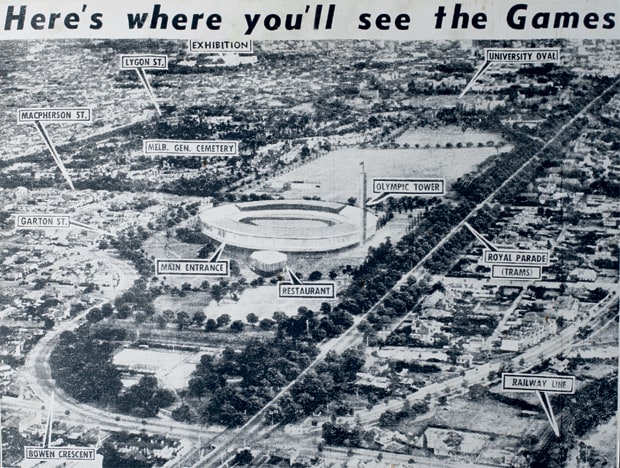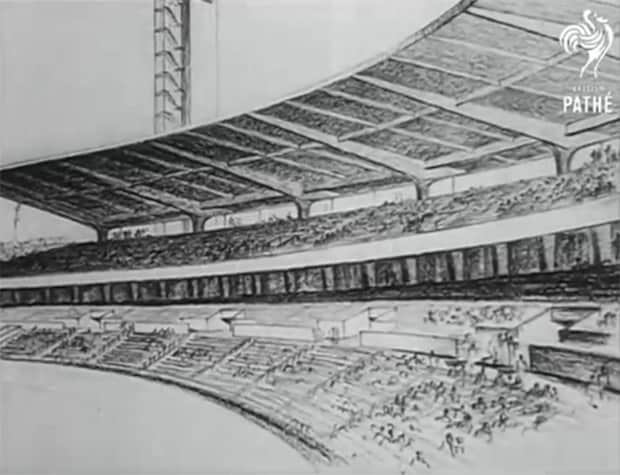AS IKON Park undergoes a dramatic multi-million dollar facelift, and on the eve of the Games of the XXXII Olympiad in Tokyo, it’s pertinent to revisit a moment in time when Carlton made an audacious play to host the 1956 Olympics at the old ground.
It was the then Carlton President – the “philanthropist and sportsman” as The Argus newspaper put it - who actually secured the 1956 Games for his beloved Princes Park – only to be thwarted at the eleventh hour by the Melbourne Cricket Club through the intervention of the then Premier John Cain senior.
Four years earlier, in 1952, Princes Park firmed as the Olympic venue when the Royal Melbourne Showgrounds were considered unsuitable and the MCG was refused on the grounds that the conversion of the arena was considered “engineeringly impracticable”.

A newspaper report on the proposed Princes Park precinct, 1952. (Image: Supplied)
On 24 March of that year, the Melbourne City Council agreed that the cost of making the Carlton Ground available as the main stadium should be borne by the Federal Government (50%), the state Government (25%) and the Melbourne city Council (25%), the council’s proportion of the cost being expected at that time to be in the vicinity of £300,000.
Under the proposal:
- Carlton would stage the Melbourne Olympiad in a redeveloped 100,000-seat stadium at Princes Park, with the now heritage-listed Ald. Gardiner Stand to be demolished;
- cost for the Princes Park redevelopment, then estimated at £1.2million would be met by the Federal Government (50%), the State Government (25%) and the Melbourne City Council (25%); and
- Carlton home matches would be staged at Coburg Oval for the duration of the four-year redevelopment.
The Melbourne City Council voted nine to one that the Carlton Ground should be the main stadium, the council’s representatives having moved and seconded the motion.

An artist's impression of the exterior of the Princes Park ground. (Photo: Supplied)
But to quote Robert Burns, “The best laid plans of mice and men often go awry” – and so it was for KG Luke’s Carlton committee in what fast became a five-ring circus.
It was later determined that costs for redevelopment of the stadium would be “considerably in excess of that originally anticipated”.
At subsequent meeting called by the then Premier John Cain, it was resolved that the Melbourne Cricket Ground authorities had altered their previous views, “and declared that the ground would now be made available for the Games.
On February 2, 1953, barely a year after the Carlton ground was confirmed as the Olympic venue, the MCG was unanimously declared the beneficiary of a venue switch. This followed an announcement by the Premier that no State Government funding would be available for the Carlton stadium.
The games control committee chairman AW Coles told reporters “I am very sorry we are not going to get a nice stadium at Carlton, but the Premier has decided that finance will be available only for the MCG”.
“We must, therefore, all get behind this and try to gain approval of the IOC so that Melbourne will not lose the games,” he said.
According to John Cain senior, the overall cost of staging the games in Melbourne would be £850,000, which included £300,000 for bringing the MCG to Olympic standard, £350,000 for the Olympic pool and about £200,000 for other works, including the cycling track. This, he said, amounted to £400,000 less than the original amount agreed upon the previous year, with the Federal Government to commit 50% in funding, and the State Government and City Council 25% each.
Interestingly, the Prime Minister and MCG Trustee Sir Robert Menzies, whose allegiance to Carlton and friendship with Ken Luke were lifelong, left what was reported as a heated 2½ hour meeting without making comment.
The following bitter account appeared in Carlton’s 1953 Annual Report, beneath the headline OLYMPIC GAMES AND THE CARLTON GROUND.
“Fortunately, all references in the last annual Report to the possibility of the Olympic Games being staged at the Carlton Oval were prefaced by the phrases “almost certain” or “most likely”.

The proposed stadium redesign, 1952. (Photo: Supplied)
This was a most necessary precaution for even at that stage, and despite the progress made by architects in the planning of the stadium, most of the club officials knew that certain forces, jealous of the Carlton project at the beginning, were at work to have the site changed. This was more in evidence when it was known that the Carlton plan was based on catering for over the 100,000 persons.
“Thus, it is not such a great shock when the ground which originally rejected the Games was re-chosen.
“Recriminations on how the volte face was accomplished will serve no purpose for after all, the public have short memories on these matters. Sufficient it is to record that posterity will have no thanks for those who deprived Melbourne of a second main ground – and a truly people’s ground at that – which will be sorely needed when the City reaches the expected 2,000,000 population mark about 1980.”
It’s 65 years ago this November, high atop the MCG’s old Northern Stand, that the late Ron Clarke put fizzling flame to cauldron to open the Games of the XVI Olympiad in Melbourne.
Clarke burnt his arm in the process, but the damage was minor and superficial – and yet for Carlton President Ken Luke, the scars of the 1956 Melbourne Olympics would run deep and linger a lifetime.



